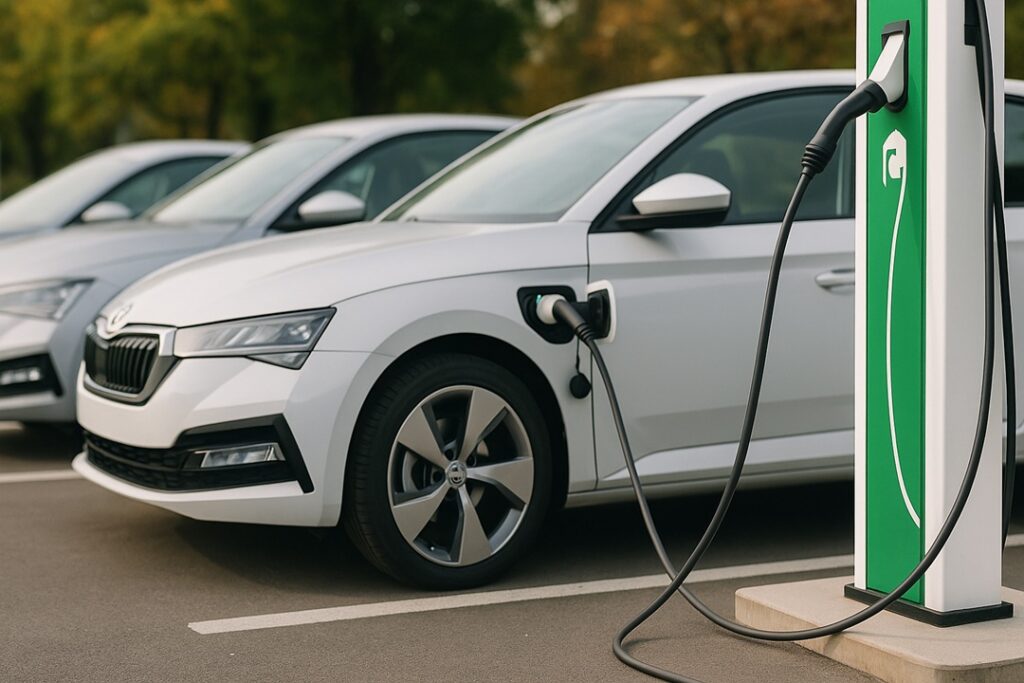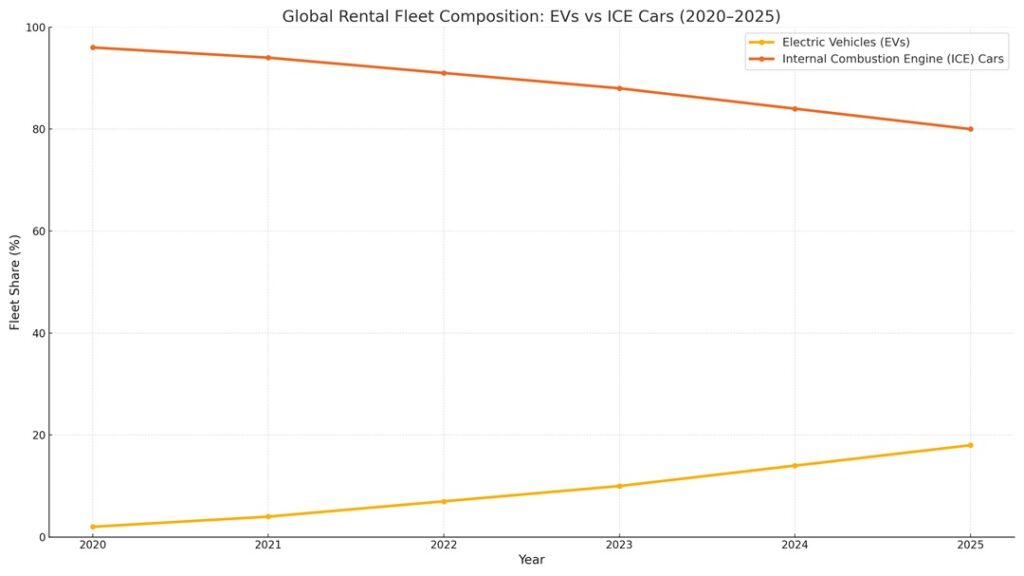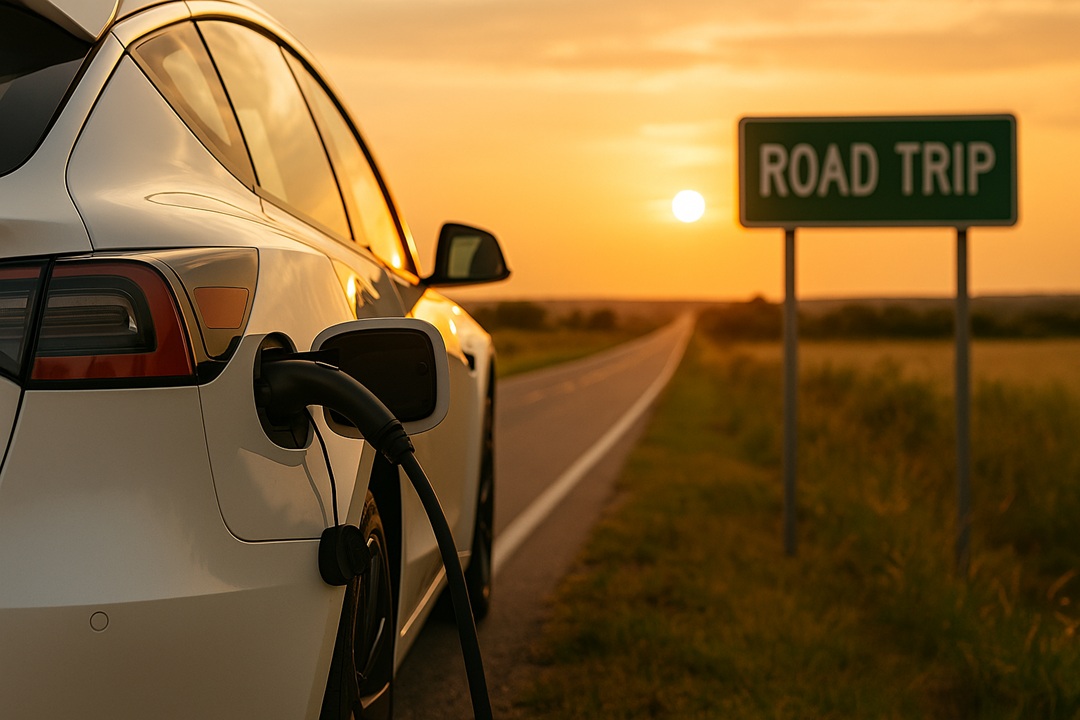From Editorial Team, America Best Car Rental
From Niche to Normal: How EVs Went Mainstream in Rentals
Just a few years ago, renting an electric car felt like a novelty—a cool experiment, but not something most travelers considered practical. You might have seen a lonely Nissan Leaf parked among a sea of gas-powered sedans or stumbled across a Tesla Model 3 on a premium rental tier. But things have changed. Fast. In 2025, electric vehicles (EVs) are no longer the exception. They’re becoming part of the everyday rental landscape.
In the United States, Hertz was one of the first major rental companies to make headlines with its bold EV move. Back in 2021, they announced plans to purchase 100,000 Teslas, signaling a new era of electrification. While that plan later encountered challenges—including higher-than-expected repair costs and concerns over residual value—the message was clear: EVs were no longer optional add-ons. They were the future.
Meanwhile, in Europe, where regulations have aggressively favored cleaner vehicles, rental fleets began shifting even earlier. Countries like Norway, where EVs represent more than 80% of new car sales, have made it increasingly impractical to ignore the trend. If you’re picking up a car in Oslo today, chances are high it runs on electrons, not gasoline.
Why Rental Companies Are Betting Big on EVs
It’s not just about optics or going green for the sake of marketing. EVs offer real economic incentives for rental companies. With fewer moving parts than internal combustion vehicles, EVs are cheaper to maintain in the long run. There’s no need for oil changes, spark plugs, or exhaust systems. Brake wear is reduced thanks to regenerative braking, and electric drivetrains tend to be more reliable overall.
Fuel savings also make a big difference. For a fleet of thousands, shaving even a few dollars off per-day fuel costs adds up quickly. And with rising fuel prices in many parts of the world, EVs allow rental agencies to better predict operational expenses.
Then there’s the regulatory pressure. In Europe, emissions-related penalties and tax incentives make gasoline fleets less profitable. The European Union’s push to ban new internal combustion engine (ICE) sales by 2035 has nudged companies like Sixt and Europcar to start electrifying now, not later. Even in the US, states like California are implementing clean fleet mandates that affect rental operations directly.
And of course, customer demand is shifting. Travelers are curious about EVs, especially those who haven’t had a chance to drive one yet. For some, renting an EV is a test drive wrapped into a vacation.
What It Means for You: The EV Rental Experience

So what’s it actually like to rent an electric car? The answer depends a lot on where you are. In Los Angeles or San Francisco, it’s relatively seamless. Charging stations are easy to find, and many hotels offer EV chargers in their parking lots. In more rural areas, things can get trickier. Renting an EV for a road trip through Utah or the Adirondacks? You’ll want to plan your charging stops carefully.
The driving experience itself is usually a pleasant surprise for new EV users. Instant torque, quiet operation, and high-tech interfaces make electric rentals feel modern and smooth. But there is a learning curve. Drivers accustomed to gas stations and gear shifts might need a minute to get used to range estimations, regenerative braking, or touchscreen-only controls.
One common friction point is the charging process. Plug types differ, charging speeds vary, and some stations require apps or memberships. Tesla owners benefit from the simplicity of the Supercharger network, but renters using brands like Kia, Polestar, or Nissan may face a patchwork of options. Electrify America, EVgo, and ChargePoint are expanding rapidly, but they don’t yet rival the density or ease-of-use of traditional gas stations.
Still, for many renters, the challenge is part of the adventure. Whether you’re zipping down Highway 1 or cruising through Amsterdam, there’s a certain thrill to mastering the nuances of EV travel.
Real Stories from the Road
Take Lisa, for example, a digital nomad from Chicago who rented a Polestar 2 during a two-week trip across Spain. She shared that the car was “a dream to drive,” but admitted to spending an hour her first night trying to figure out a compatible charging station in Seville. Once she got the hang of it, she said the whole experience was smoother than expected. “By the end of the trip, I was checking range like I used to check gas prices. It felt natural.”
Or Mark, a retiree from Florida who tried out a Tesla Model Y in San Diego. “I wasn’t sold on the idea of an EV,” he said, “but that car made me feel like I was in the future. I didn’t expect to like it as much as I did.”
The Charging Challenge: Still a Work in Progress

Here’s where things get real. Charging remains the most significant barrier to widespread EV rental adoption. The issue isn’t just the number of chargers—it’s about reliability, accessibility, and clarity.
A 2024 study by J.D. Power found that over 20% of public EV chargers in the US were either out of order or malfunctioning at the time of testing. That number drops in countries with more mature infrastructure like Norway or the Netherlands, but even there, peak-hour congestion can lead to long waits.
Urban areas are generally well-equipped. Rent an EV in Paris or New York, and you’ll find chargers in parking garages, street corners, and even shopping centers. But rural destinations still pose a risk. Cross-country travel requires detailed route planning and some backup options—something not all renters are used to doing.
To make things easier, rental companies have started including charging cards, mobile app guidance, or partnerships with network providers. Sixt in Germany, for instance, offers access to Ionity fast-chargers through bundled packages. In the US, some Hertz locations now provide Tesla adapters and a quick EV intro video for new renters.
Still, the need for standardization is real. Until charging becomes as intuitive and ubiquitous as pumping gas, EV rentals will continue to feel like a different category entirely.
What About Cost?
For many customers, pricing remains a key factor. So is it cheaper to rent an EV? In 2025, prices have largely stabilized. Daily EV rental rates are often comparable to mid-size gasoline vehicles, though in premium markets, EVs like Teslas can still carry a slight markup.
But the real savings come after pickup. Drivers can save significantly on fuel—especially if they charge overnight at hotels or use free public stations. Some EV rentals even include charging credits or partnerships that further reduce the cost. Over the span of a weeklong trip, that can translate to real dollars.
That said, renters need to factor in time. Charging can take longer than a quick gas stop, especially on slower Level 2 chargers. For travelers on tight schedules, this is a trade-off worth considering.
Are Travelers Ready for the Switch?
This is the million-dollar question. A growing number of customers are open to renting EVs, but adoption is uneven. Business travelers tend to favor EVs for short, predictable commutes in urban areas. Tourists, especially international ones, may hesitate due to unfamiliarity with local charging systems or range anxiety.
Rental companies are aware of this and are adjusting. Some offer hybrid options as a bridge. Others, like Avis, are rolling out step-by-step EV guides with QR codes that explain charging and driving basics. The idea is to remove as much friction as possible.
Still, the psychological barrier remains. Many travelers stick to what they know—gas-powered cars with no surprises. For them, EVs can feel risky or confusing. That’s starting to change as more people experience EVs firsthand. For many, all it takes is one smooth ride in a Model Y to shift their entire perspective.
Business and Corporate Rentals
Another growing segment for EV rentals is the corporate market. Companies looking to reduce their carbon footprint are increasingly renting EVs for employee travel, conferences, and urban delivery fleets. In cities like Amsterdam, Berlin, and San Francisco, EVs have become a default option for short-term commercial use.
Fleet managers appreciate the lower operating costs, and employees often enjoy the tech-forward feel of EVs. With new government incentives tied to sustainability targets, renting electric has become not just a smart environmental move, but a financial one too.
EVs vs. Gas-Powered Cars
Here we show how the balance between electric vehicles and internal combustion engine (ICE) cars has shifted in rental fleets from 2020 to 2025. The chart highlights the steady growth of EV adoption and the gradual decline of traditional gasoline and diesel-powered vehicles.

EV Rentals Abroad: A Glimpse into the Future
If you want to see where the EV rental market is headed, look outside the US. In Europe, countries like Norway, Germany, and the Netherlands are pushing aggressively toward all-electric fleets. Sixt, Europcar, and other regional players have already committed to 70–90% EV penetration by 2030.
In Southeast Asia, companies like Grab are integrating EVs into short-term rental and ride-sharing programs. In Vietnam, Xanh SM is rapidly building out a rental fleet made up almost entirely of electric cars. These markets benefit from strong government incentives and urban environments where short-range travel makes EVs the ideal solution.
Travelers in these regions are often surprised at how advanced the systems are. Booking an EV online, accessing charging apps, and navigating dense urban areas has become surprisingly simple. In many ways, these countries offer a preview of what the American rental market could look like in five to ten years.
The Road Ahead: What’s Next for Electric Rentals?
There’s no doubt that electric vehicles are transforming the rental market, but the journey is far from over. In the next few years, we can expect a more deliberate rollout of EVs in areas with the right infrastructure, followed by broader adoption as technology and convenience catch up.
Government policies will play a huge role. States like California, New York, and Washington are setting aggressive EV mandates that rental fleets will have to meet. Meanwhile, improvements in battery range, charging speed, and vehicle availability will make electric rentals more appealing to the average traveler.
The tipping point will likely come when renting an EV feels exactly like renting a regular car. No learning curve, no special apps, no planning marathons—just drive, plug, go.
Until then, electric rentals are still part innovation, part experiment. But they’re here. And they’re growing fast.
| COMPANY | REGION | EV SHARE (2025) | NOTES | REGIONAL ANALYSIS |
|---|---|---|---|---|
| Hertz | USA | ~10% | After failing to reach its 25% EV target, the company is selling off around 20,000 electric vehicles | USA: Still a low EV share. Main challenges are high costs, limited demand outside California, and weak charging infrastructure |
| Avis | USA | ~5–7% | Gradual growth of EV fleet, including Tesla Model 3 and Model Y | USA: Cautious EV expansion. The focus is more on flexible, multi-fuel strategies |
| Enterprise | USA | ~5% | EVs are present but limited. The company is mainly focused on hybrids | USA: Slow EV development, with a focus on hybrids and gasoline vehicles in the mass market |
| Sixt | Europe | ~12–15% | Actively expanding: target of 70–90% EVs by 2030. EVs available in all key EU countries | Europe: Ahead of the US. Strong government support, high ICE taxes, and a well-developed charging network |
| Europcar | Europe | ~10% | Promoting EV models in major European cities, including Polestar 2 and Renault Zoe | Europe: EVs are increasingly used in large cities. Europcar features several local electric models |
| Grab | Southeast Asia | ~20% | Partnered with BYD to build out EV fleet for urban use. Also investing in charging infrastructure | Asia: Fast EV integration supported by government initiatives and direct partnerships with manufacturers |
| Europcar | Vietnam | ~30% | Regional leader in EV rentals. Highest EV share among Asian operators | Vietnam: Xanh SM is a prime example of rapid EV fleet transformation focused on sustainability |
Whether you’re chasing sunsets along California’s Highway 1, winding through the Dolomites in northern Italy, or navigating neon-lit streets in Southeast Asia, electric cars are becoming a reliable companion for modern road trips. Sure, there’s a bit of a learning curve, and maybe one or two wrong turns at a charging station. But that’s all part of the story now. The open road is changing—and EVs are right there, humming quietly into the future. So the next time you’re handed the keys at the rental counter, maybe it’s time to say yes to the electric option. Who knows? Your best trip yet might just start with a plug.
